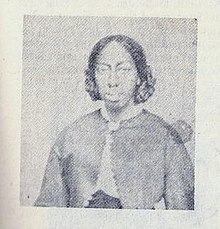Eliza Ann Gardner | |
|---|---|
 | |
| Born | May 28, 1831
New York City, U.S. |
| Died | January 4, 1922 (aged 90)
Boston, U.S. |
| Known for | |
Eliza Ann Gardner (May 28, 1831 – January 4, 1922) was an African-American abolitionist, religious leader and women's movement leader from Boston, Massachusetts. She founded the missionary society of the African Methodist Episcopal Zion Church (AMEZ), was a strong advocate for women's equality within the church, and was a founder of the National Association of Colored Women's Clubs. [1]
Early life
Eliza Ann Gardner was born in New York City to James and Eliza Gardner. As a child she moved with her family to Boston, where her father had a successful career as a ship contractor. Their West End neighborhood was an important center of Boston's African-American community and the abolitionist movement. The school she attended, the only public school for black children in Boston at the time, was taught by abolitionists. Her parents were politically active, and the family home at 20 North Anderson Street was a stop on the Underground Railroad. She was also a relative of W. E. B. Du Bois. [2] [3] Gardner was a gifted student and won several scholarships, but because academic and professional opportunities for black women were limited, she trained as a dressmaker. [4] [5]
Career
As a young woman, Gardner became active in her church and in the anti-slavery movement while making her living as a dressmaker, and later as keeper of a boarding house. As an activist she knew and worked with many abolitionist leaders including Frederick Douglass, William Lloyd Garrison, and Wendell Phillips. [6]
Meanwhile, she also taught Sunday school for the African Methodist Episcopal Zion church, eventually being named Boston's Sunday school superintendent. In 1876 she founded the Zion Missionary Society in New England to raise funds to send missionaries to Africa. Gardner is referred to as the "mother" of the organization, which later came to be known nationally as the Ladies' Home and Foreign Missionary Society. [7]
Gardner's fundraising efforts met with resistance in 1884, when members of the male-dominated AMEZ Church objected to the creation of a women's society. At the church's quadrennial conference, Gardner successfully defended the role of women in the church:
I come from Old Massachusetts, where we have declared that all, not only men, but women, too, are created free and equal....If you commence to talk about the superiority of men, if you persist in telling us that after the fall of man we were put under your feet and that we are intended to be subject to your will, we cannot help you in New England one bit. [4]
She was instrumental in persuading the church to allow women to be ordained as ministers, [8] urging them to "strengthen [women's] efforts and make us a power." [9] In 1895, when female chaplains were a rarity, she served as the chaplain of the First National Conference of the Colored Women of America. [6] She was a founding member of the Woman's Era Club of Boston, the city's first black women's club. She was involved in the formation of the National Association of Colored Women, and was featured as an honored guest at their biennial convention in New York in 1908. [4] Alongside other black Bostonians, she opposed segregated schools, supported fugitives, and advocated for abolition of enslavement. [10]
Gardner never married, and had no children. She died in Boston in 1922. [4] The Gardner Memorial A.M.E. Zion Church in Springfield, Massachusetts is named in her honor. [11]
Publications
- A Historical Sketch of the A. M. E. Zion Church of Boston, 1918
See also
References
- ^ "Eliza Ann Gardner (U.S. National Park Service)". www.nps.gov. Retrieved 2021-03-25.
- ^ Christianson, Scott (21 July 2015). "When Du Bois lived here". The Berkshire Edge. Retrieved 9 December 2015.
- ^ Carrillo, Karen (2012). African American History Day by Day: A Reference Guide to Events. ABC-CLIO. p. 168. ISBN 9781598843613.
- ^ a b c d Smith, Jessie Carney (1996). Notable Black American Women. VNR AG. pp. 239–240. ISBN 9780810391772.
- ^ Brown, Hallie Q. (1926). Homespun Heroines and Other Women of Distinction. Aldine Pub. Co. pp. 117–118. ISBN 9780199763092.
- ^ a b Jones, Martha S. (2009). All Bound Up Together: The Woman Question in African American Public Culture, 1830–1900. University of North Carolina Press. pp. 173–174. ISBN 9780807888902.
- ^ Aaseng, Nathan (2003). African-American Religious Leaders. Infobase Publishing. p. 81. ISBN 9781438107813.
- ^ Jones, p. 192
- ^ Griffith, R. Marie (2006). Women and Religion in the African Diaspora. JHU Press. p. 128. ISBN 9780801883705.
- ^ "Black Bostonians Fought For Freedom From Slavery. Where Are The Statues That Tell Their Stories?". www.wbur.org. 16 June 2020. Retrieved 2022-04-02.
- ^ "History of Gardner". Gardner Memorial A.M.E. Zion Church. Archived from the original on 8 December 2015. Retrieved 8 December 2015.
- 1831 births
- 1922 deaths
- Abolitionists from Boston
- Activists from New York City
- African-American abolitionists
- African-American history in Boston
- African-American Methodists
- American women's rights activists
- Methodist abolitionists
- People from Boston
- People of the African Methodist Episcopal church
- Women Protestant religious leaders